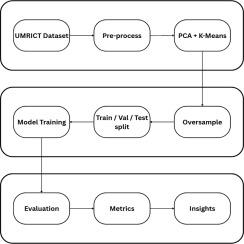Method for fetal ultrasound image classification using pseudo-labelling with PCA-KMeans and an attention-augmented MobileNet-LSTM model
IF 1.9
Q2 MULTIDISCIPLINARY SCIENCES
引用次数: 0
Abstract
Accurate classification of fetal ultrasound images is critical for early diagnosis, yet remains challenging due to limited labeled data and high inter-class variability. This study presents a robust deep learning framework that combines a MobileNet backbone with multi-head self-attention and LSTM layers to enhance feature learning and temporal context. To address data scarcity and imbalance, unsupervised clustering was employed using Principal Component Analysis (PCA) for dimensionality reduction and K-means (k=4) for pseudo-label generation. These pseudo-labeled clusters were then balanced using oversampling techniques. The proposed model was trained using transfer learning on the augmented dataset and achieved a test accuracy of approximately 98 % with a macro-F1 score of 0.98, indicating highly reliable classification performance.
- •Employed PCA (100 components) and K-means (k=4) for effective pseudo-labeling and class balancing.
- •Designed a hybrid deep learning architecture using MobileNet, multi-head attention, and LSTM.
- •Achieved ∼98 % test accuracy and 0.98 macro-F1 score, demonstrating strong model generalization.

基于PCA-KMeans和注意增强MobileNet-LSTM模型的胎儿超声图像伪标记分类方法
胎儿超声图像的准确分类对早期诊断至关重要,但由于有限的标记数据和高类别间变异性,仍然具有挑战性。本研究提出了一个强大的深度学习框架,该框架将MobileNet骨干网与多头自注意和LSTM层相结合,以增强特征学习和时间上下文。为了解决数据稀缺和不平衡问题,采用无监督聚类,使用主成分分析(PCA)降维,k -means (k=4)生成伪标签。然后使用过采样技术平衡这些伪标记簇。该模型在增强数据集上使用迁移学习进行训练,测试准确率约为98%,宏观f1分数为0.98,表明分类性能高度可靠。•采用PCA(100个分量)和k -means (k=4)进行有效的伪标记和类平衡。•使用MobileNet、多头注意力和LSTM设计混合深度学习架构。•实现了~ 98%的测试精度和0.98的宏观f1分数,显示出强大的模型泛化。
本文章由计算机程序翻译,如有差异,请以英文原文为准。
求助全文
约1分钟内获得全文
求助全文
来源期刊

MethodsX
Health Professions-Medical Laboratory Technology
CiteScore
3.60
自引率
5.30%
发文量
314
审稿时长
7 weeks
期刊介绍:
 求助内容:
求助内容: 应助结果提醒方式:
应助结果提醒方式:


